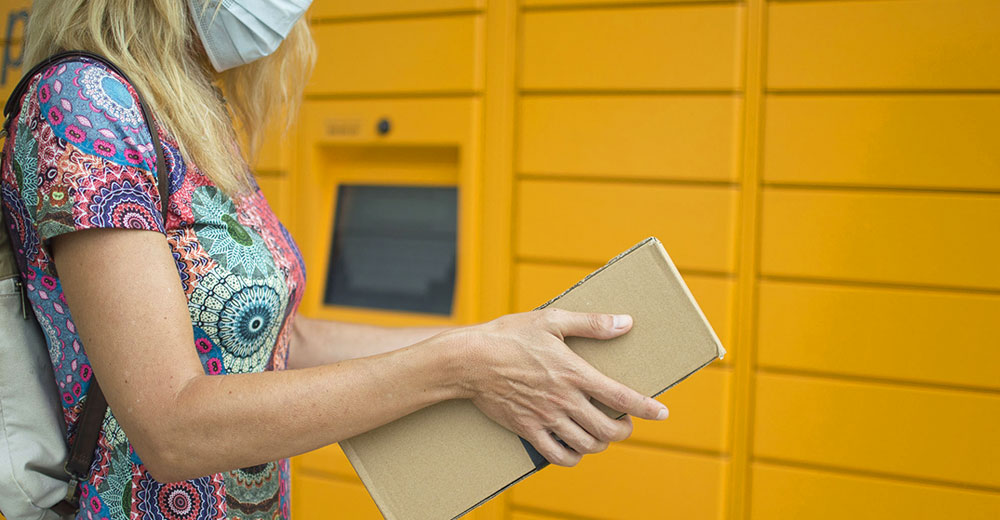Even before the COVID-19 pandemic, contactless payments stood as one of the most noticeable changes in the retail industry.
According to a Forbes Technology Council post, the global contactless payments market size is expected to go from $10.3 billion in 2020 to $18 billion in the next five years.
When dealing with purchases and deliveries, the desire for contactless “everything” is not a trend; it’s a paradigm shift in the way people shop and receive packages at their homes.
Retail
In the past, contactless transactions were a convenient method of paying at the checkout counter. Who doesn’t like to tap a credit card or wave their smart device over a reader to register a sale? However, due to COVID-19, this convenience has shifted to a health concern because shoppers want to limit as many physical interactions with store employees as possible.
Now, retailers are adopting new ways to service customers, including a heavy emphasis on curbside pickups and local deliveries. Consumer-driven desires are truly changing the way retail operates.
A study by Incisiv during July and August 2020 confirms this by finding that 80 percent of shoppers expect to increase BOPIS (buy-online-pickup-in-store) and curbside pickup over the next six months, and 90 percent of shoppers prefer home delivery over a store visit.
Retailers are finding new ways to retool their customer experiences to conform with the new contactless “everything” supply chain, and artificial intelligence (AI) and computer vision technologies are lending a notable hand.
Out are the bulky metal lockers where customers had to open doors that many other people have come in contact with to retrieve their items staged from online purchases.
Replacing lockers are smart shelving systems using AI, computer vision, and pick-to-light technologies that allow organizations to track and monitor items while also providing a digital breadcrumb trail for the organization and consumer.
This is a welcomed change that is bringing more flexibility to a once rigid retail fulfillment model, and it’s being embraced by Main Street local businesses as well as large retailers such as Walmart, Target, Best Buy, Urban Outfitters, and Dick’s Sporting Goods — all of which cited BOPIS as a game changer on recent earnings calls.
In fact, BOPIS drove Thanksgiving Day 2020 online sales up 21.5 percent to a new record $5.1 billion, according to Adobe Analytics. An effective BOPIS fulfillment solution can improve store experiences with safe, secure, and fast merchandise retrieval or returns.
It’s important to note that all BOPIS systems are not alike, and merchants who are considering embracing omnichannel click-and-collect programs need to know the differences. The top three things retailers need to consider when selecting a BOPIS solution are:
- Expedite Retrieval. The time between customers’ arrival and having the purchased merchandise in their hands should take no more than two minutes. Speed is an asset; customers who wait more than two minutes for their items will typically not engage in repeat business.
- Scalability. Good systems scale not just with the retailer’s everyday volume but also easily expand to handle seasonality increases. If the BOPIS system does not scale well, it will either be under or over capacity at any particular time.
- Flexibility. The same system needs to be user and staff-friendly while accommodating various-sized items. BOPIS systems that utilize shelving in lieu of a locker-based approach are inherently more flexible due to the open spaces to stage items as opposed to finite locker dimensions that may limit storage possibilities. These shelving-based systems can also be used for curbside pickup as well as in-store, consumer-served merchandise retrieval.
REITs
A similar trend is happening in large apartment complexes where residents want to avoid contact with delivery personnel or facility management, fearing COVID-19 exposure. They, too, prefer a contactless experience when retrieving their delivered packages.
Package management is extremely important when you consider that by 2022, Amazon’s U.S. package delivery volume could more than double to 6.5 billion. That would beat UPS’s 5 billion and FedEx’s 3.4 billion package volume by that time, according to Morgan Stanley.
The contactless desire is not a fad that will dissipate with the arrival of a new vaccine. It’s a process that will remain a part of our lives. The need for large residential package retrieval has the same traits as retail purchases. That is, people want to limit their person-to-person contact as much as possible but still need to acquire items for everyday living.
For REITs (owners of multi-unit residential properties, student-housing facilities, office complexes, and mail centers), couriers can now access smart package rooms using a key fob with near field communication (NFC), then scan package labels which automatically assign them to residents.
Packages then are placed on a shelf inside the room where the same computer vision technology used for retail monitors and tracks every item. Upon package retrieval, residents scan their QR code and are guided by laser and audio prompts to obtain their packages — with zero personal contact.
Using these smart package rooms for tenants goes far beyond providing a contactless environment; it also introduces a much-needed element of security. According to a 2020 C+R Research study:
- Forty-three percent of Americans have been a victim of package theft.
- Sixty-one percent say they know someone who has had a parcel taken.
- Forty-three percent say they know a neighbor who was victimized.
- The average cost of a stolen package is $136.
Residents tried to get creative to protect their packages by installing doorbell surveillance cameras, requesting drivers to hide packages, and sending deliveries to friends and relatives. However, the same 2020 C+R Research study identified the number one theft prevention method preferred by residents was an in-store pickup, and given today’s pandemic climate, shoppers are doing more business with retail locations that offer a contactless experience.
But it’s not only the residents who are losing money when packages are stolen; the retail locations are losing money, too, as package thefts severely impact the bottom line for businesses. C+R Research also concluded that it costs businesses $109 on average to replace stolen items. This includes the full cost of the stolen item and the shipping and handling of the same order twice, not to mention the additional time spent to serve a single customer that could be used to grow the business.
Conclusion
When it comes to in-store retail and at-home package reception, high-touch interactions must be replaced with digital conveniences. Face-to-face interactions with sales reps and delivery persons are welcome experiences, but today, many of them need to evolve into safe and secure, self-service operations.
To achieve this, retailers don’t need to retool their existing point-of-sale (POS) systems, and REITs do not need to sacrifice large square footage. There are innovative and intelligent solutions that can quickly be set up to meet the new BOPIS and package management criteria.
Retail organizations that embrace a contactless “everything” experience will realize more repeat business with lower costs, and REITs adopting this philosophy will find happier and longer-staying tenants.













































